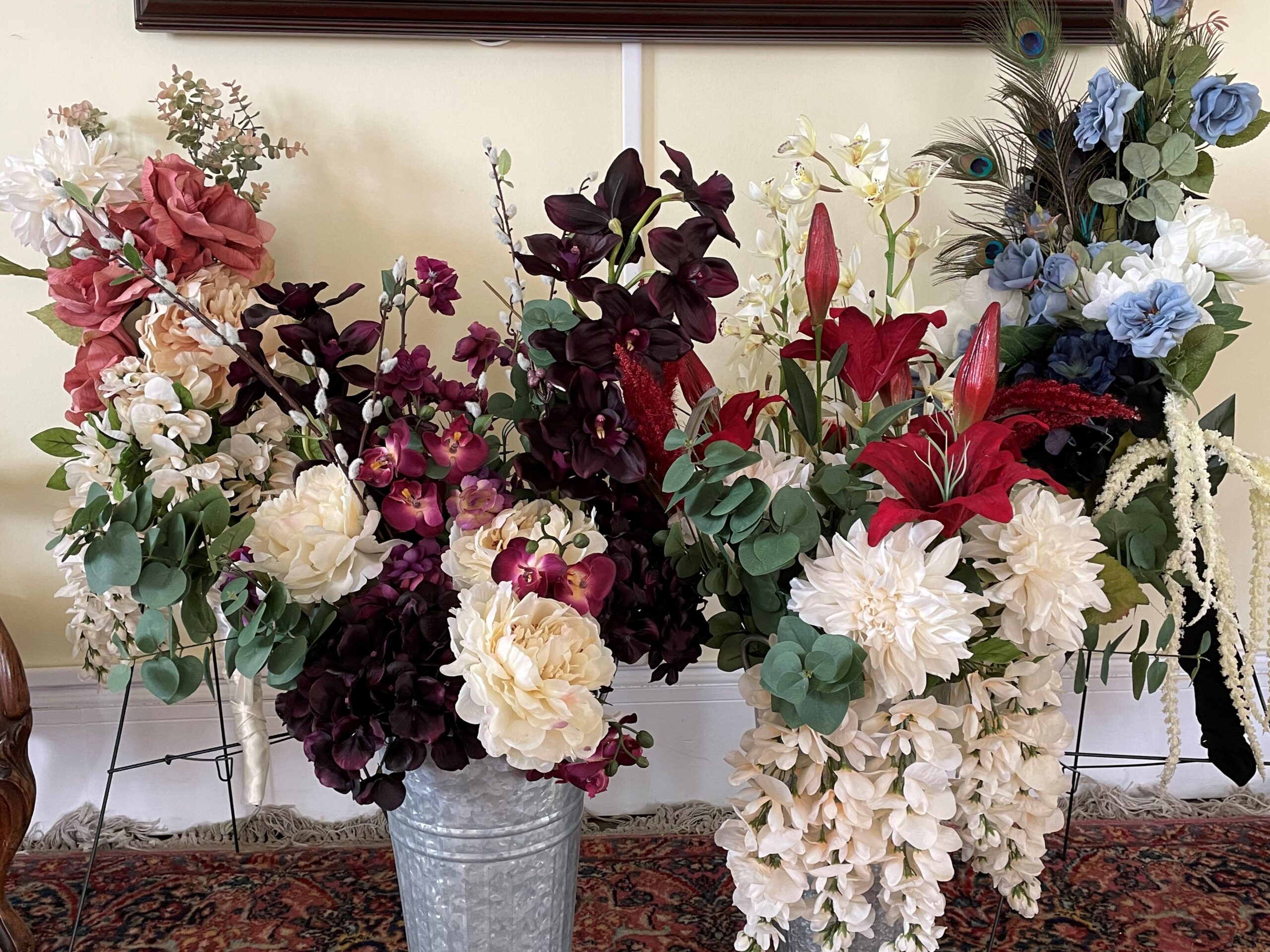In preparation for the upcoming Day of the Dead, I thought I’d discuss the language of funeral flowers. The current exhibition at the Kelley House, “Good Mourning, Mendocino: Funeral Rites and Customs,” features a number of floral arrangements that highlight some of the meanings inherent in sepulchral floral bouquets. Learning the special symbolism of flowers became a popular pastime during the Victorian era. There were guidebooks for deciphering what message was being conveyed by the color and type of flower in a bouquet. No one back in the late 1800s thought that “a rose is a rose.” It was always so much more!
Among the floral arrangements in the exhibit are five color schemes: red, blue, purple, pink, and white. White is the most common flower color since it represents elegance, reverence, purity, and eternal love. The two wreaths hung in the exhibition feature calla lilies and white peonies. The peonies convey compassion and healing, and calla lilies, one of the flowers most associated with funerals, represent resurrection and rebirth.

Floral arrangements from the Kelley House Museum’s current exhibition, Good Mourning Mendocino: Funeral Rites and Customs.
Below the wreaths stand the pink and blue arrangements. Pink represents grace, compassion, and innocence. That arrangement consists of peonies, chrysanthemums, and wisteria. The chrysanthemums symbolize truth, lamentation, and grief, and the wisteria can represent purity, innocence, and a love that transcends death.
The blue in the second bouquet represents sadness, sympathy, and peace. This arrangement features roses, hydrangeas, and peacock feathers. It is common knowledge that roses are a symbol of love, but blue roses do not grow naturally and must be created with dye; because of this, the blue rose represents unattainable love. The hydrangeas represent heartfelt emotions and, since they are a perennial bloom, they also symbolize remembrance. The last feature of this arrangement, the peacock feathers, represent respect, honor, and rejuvenation.
Across the room are the purple and red arrangements. My personal favorite, the purple one features peonies, hydrangeas, orchids, and pussy willow. Purple flowers represent respect, admiration, and sympathy, while orchids represent hope, love, and courage. The pussy willow is a symbol of motherhood, receiving a blessing and, due to its association with spring, renewal.
The red bouquet symbolizes strength, respect, devotion, and love. The flowers in this bouquet are wisteria, chrysanthemums, orchids, and lilies. Although white lilies appear most often in funerary floral arrangements, the lilies in this bouquet are red, which signifies passion and a love that is unconditional and eternal.
Speaking the unspeakable is not the only important function of flowers at funerals and wakes. It cannot be forgotten that flowers once served the very practical purpose of disguising the smells of decomposing bodies. It was once a custom to have, in addition to six pallbearers, six flower ladies, whose task it was to move the flowers from the funeral service to the gravesite. These women were usually close family or friends of the deceased, and the task provided a ceremonial way for those people to honor the dead person.
Flower symbolism also influences what is engraved on tombstones. Flowers and garlands carved into headstones help to tell the stories of the departed. The upcoming Kelley House tour of Evergreen Cemetery—on October 30th at 11:00 am—will illuminate headstone symbolism and share the stories of long-departed Mendocino residents. Reservations for the special pre-Halloween tour can be made through Airbnb Experiences, linked on the Kelley House Museum website under walking tours. Reservations can also be made by calling the office at (707) 937-5791.
The Kelley House Museum is open from 11:00 AM to 3:00 PM Thursday through Sunday. If you have a question for the curator, contact her at curator@kelleyhousemuseum.org to make an appointment. Walking tours of the historic district depart from the Kelley House regularly: Tour Schedule